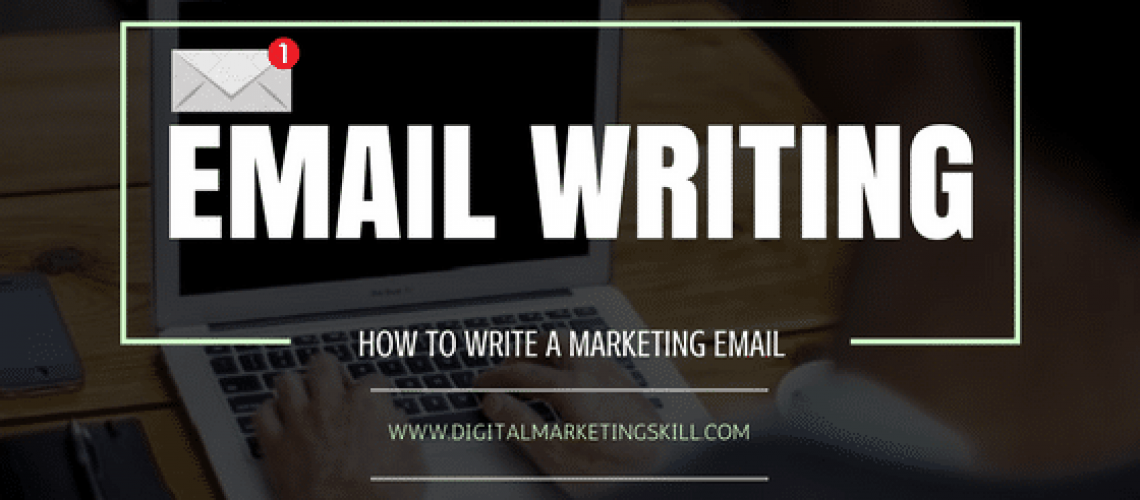Email writing is one of the most essential, most vital yet most commonly overlooked aspects of business.
Whether you’re writing to other businesses, customers, clients, partners or to internal employees, the way you craft and compose your emails has a huge effect on how people perceive you and your business.
Even with slight changes to the way you write, you can revolutionise the way you get your messages across, the way you communicate with people and the way you sell your products and services.
One of the most important emails you will compose is a marketing email. It doesn’t matter whether you’re midway through a campaign or just trying out new ideas on how to draw in leads and new customers, the way you write and compose your emails will be the make or break factor for your success.
To give you a helping hand, today we’ll explore the best ways to write a marketing email, enabling you to maximise your opportunities.
Focus on Your Subject Line

The first and most important element of your email is your subject line. Without a captivating and enticing subject, your emails will never be opened, and therefore it will be a waste of time writing the content on the inside.
Also, many users will have emails coming in from all sorts of companies and third parties that they have signed up to over the years, so it can be difficult to make yours stand out from the crowd.
Get 50% Discount to Master ALL Aspects of Digital Marketing That Can Earn You $2,500 - $5,000 a month (Even if you are a complete beginner!)
Our students that intentionally implement what they learn from our digital marketing course make back the entire course fee within a single month or more after completing our course because our course gives them many income generating options with unlimited earning potential with no age or location barrier. The best part is no technical skills are required.
An opportunity to change your lifestyle and make money working from anywhere in the world. The results our students get from our digital marketing course prove this could be applied to any market or country and that it is designed for any skill level and work background.
*By signing up, you agree to our privacy policy and terms of service.
There are many approaches you can take when trying to create these attention-grabbing couple of words, but this is your chance to get really creative. However, it’s essential that you remain true to the branding and personality of your business.
As a rule of thumb, you’ll want to make sure that you’re using ‘actionable language’, using words like;
- Ask
- Buy
- Reserve
- Download
- Take
To help your readers immediately understand the direction your email is going to take and what they can expect. You’ll also want to make sure that your subject lines are catchy and direct.
“Another one of the best techniques of psychology to use is FOMO. This stands for Fear of Missing Out, and it’s the same concept that makes social media so addictive.
This is a kind of proven psychology that humans have that feel the need to be part of a greater community or presence, one of the main driving forces behind social media,” shares Paul Harker, an email marketer for Essay Services.
Create subject lines that will make the user feel like they’re missing something out of their lives if they don’t open your emails.
Be Personal

One of the best ways to connect with the readers you’re trying to sell to is to remain personal at all times.
This means to stop referring to your readers as readers, followers, subscribers or any other collective term you may use. Make it direct and compose your emails as though you’re writing to just them.
Additionally, refer to yourself using the name in your email address. This makes you a lot more reputable and makes it feel like the reader is talking to another human being, rather than a business or organisation.
Writing in Second Person
Hand in hand with the consideration above, it’s important that you write in second person, much like this article is.
This means using words like ‘you’ and ‘your’, so you’re addressing the reader directly, therefore making the email a lot more personal and relatable.
Feel free to use a context created using words like ‘we’ and ‘we’re’ as this can also help your customers and readers connect with your business.
This ensures the focus of your emails stays on your customers, rather than getting caught in the trap of talking just about your business, products and services.
Provide Benefits

Nobody wants to read something that won’t benefit them in some way or another. It may seem selfish but why would people use up their valuable time reading something that makes no difference in their lives.
Whatever it is you’re talking about and whatever industry you’re representing, always ensure that there’s something in the email that the reader can take away and learn from.
Alternatively, to lock in those sales, you could even provide discount codes to your online store or service. Even if you’re offering a 5% discount, people respond to this as they believe they are getting a good deal.
Benefits Over Features
Now on sale: Our brand-new 50-inch LED television with Dolby Surround Sound, a voice-controlled remote, built-in Freeview and DVD player with apps for all major streaming companies.
Now on sale: Don’t miss a thing with our brand-new 50-inch LED television housing one of the highest pixel resolutions available, ensuring you see every detail of your favourite films and movies. The Dolby Surround Sound system will immerse you in crystal-clear soundtracks and conversations while finding what you love to watch has never been easier thanks to the voice-controlled remote and compatibility with leading streaming services, such as Netflix and Amazon Prime.
Of course, there are some noticeable differences in both of these product descriptions, despite them advertising the same hypothetical product.
While the first simply bullet points the features that the product has, the second goes into far more detail, not only describing the features that the product has, but also the benefit that these features will provide to your customers.
Customers don’t care if your product has 1,000 features. If they can’t see a benefit in their lives, they won’t buy the product. Every time you’re writing about a product or service you offer, re-read your descriptions to ensure that you’re talking about the benefits of your business, giving your customer a reason to shop with you.
Short, Sweet & Precise

Email writing is extremely similar to writing content for your website. You want to ensure that your emails are well laid out and have a good sense of structure. Some good rules of thumb to remember is to keep paragraphs between 100-150 words and include one main topic per paragraph.
This will dramatically increase readability and gives users the information they want in a very short space of time. Another great technique to use is to include bullet points and subheadings.
Using Online Tools for Accurate Content
Imagine you’re reading through an email and find that it’s full of mistakes. These mistakes could include spelling errors, misplaced punctuation and poor grammar.
Not only will this make your content difficult for your reader to process, but it will also actively harm the credibility and reputation of your business, as well as your legitimacy.
Instead, be aware of the fact that many online tools exist to help you create and write high-quality email content, so you’re maximising your sales opportunities.
Here are some tools to get you started;
Easy Word Count / Grammar Checker
Two free online tools to help you track the word count of your email content, and for checking the grammar.
A leading proofreading tool to help you check the accuracy of your content, so it’s free from errors.
Two free online tools to help you add references and citations to your email content, and for tips to improve your general writing skills.
UK Top Writers / Best British Essays
Two expert editing tools to help you read through your email content to ensure that it makes sense and is communicating the required message.
State of Writing / My Writing Way
Improve your writing skills by using the writing guides found on this blog, helping you to enhance your sentence structure and writing styles.
An expert tool to assist in all your writing processes, including copywriting, proofreading and editing.
Research Your Target Market

The best way for you to connect with your potential readers is to know them inside and out. For example, if you’re representing a running product company, you need to be inside the heads of runners.
What do they look for?
What are they thinking about?
What are they looking at their inboxes for?
With this information in your mind, you can create the perfect emails that will engage their minds and entice them into opening and reading your emails. Put yourself in their position.
Choosing the Right Language

Whether you’re writing the subject line or the email content itself, the language you use is extremely important and is another make or break consideration to the success of your emails.
Using power words is very important as it will help you to create mental imagery that your readers will be able to relate to.
Create a picture in the minds of your readers using words of what you’re trying to say, very similar to a story. Directive language, popularly used in calls to action are also extremely effective.
Using phrases such as; call now, download, read, click and reply are all very effective in making readers do what you want them to do.
Engage, Engage, Engage

This is the most important aspect of email marketing and writing.
If your readers are not engaged with your content, you’ve failed in what you set out to do. There is a vast amount of techniques you can use to achieve this goal.
Writing fast, as fast as you can, can help you to add personality to your content and will help you to portray a certain level of enthusiasm.
Asking your readers’ questions will also help to settle into their minds and will help you to provoke thoughts. Consequently, they’ll be drawn into wanting to know more about what you have to say, won’t they?
As mentioned above, be direct with your readers. Refer to them as ‘you’ or ‘we’. This adds a personal touch as well as a sense of belonging, ideal for making them feel part of your business.
Define Your Purpose

Finally, one of the greatest aspects of email writing you should always remember to maximise effectiveness. Define the purpose of your email, even before you start writing.
If you’re trying to get people to sign up to your website, create your emails with this in mind.
After you have finished writing, refer to your purpose to ensure your writing will have the desired effect. With the purpose clear in your mind at all times, you can be sure that you are writing to this guideline, rather than endlessly typing while trying to convey your original message.
Implement Calls to Action

This is an element of your email that we cannot stress enough.
Each and every email, in line with your purpose, needs to have a call to action to guide your reader onto the next stage of their sales journey.
It doesn’t matter if the actual content of your email is perfect and engaging, if there’s no call to action at the bottom of your email (or wherever you decide to place it), your customers won’t know what to do next, and all your hard work will be for nothing.
Make sure your calls to action are clearly identifiable from the rest of your content and have their own customised text to really encourage your reader to click on it.
This means using actionable language that’s short and sweet, such as ‘Click here to secure your order’ or ‘claim your 10% discount now’. A sense of urgency is also a highly recommended tactic, i.e. “Place your order before it’s too late!”
Consider Mobile Devices

Finally, it’s important to remember the fact that the majority of all internet traffic now comes through mobile devices, such as smartphones and tablets, so you’ll need to make sure that you’re optimising your emails, so they can be viewed effortlessly from these platforms.
This means breaking your paragraphs up into small and easily digestible sections, so your reader can easily consume them, as well as making sure all the formatting, layout and images are optimised to be viewed without an issue.
Providing the best reader experience within your emails is paramount if you want them to succeed.
Author:
Jennifer Scott works as an online editor at Revieweal (https://revieweal.com/). Also, Jennifer is a business developer that works in different areas of education, technology and various types of online marketing and online education. Prior to business developing she was a consultant at Deloitte, and managed security services provider and developer of a wide range of marketing, finance, education and security solutions.
More on Email Marketing:
- Email Marketing Strategy | 11 Tips Digital Marketing Experts Use Today
- How to Setup Email Newsletter (Creating Emails Like a PRO!) in 10 Minutes
- 13 Best Email Marketing Tools (Software) to Boost Conversion and Sales
- 17 Benefits of Email Marketing For Small Businesses (Why it is Important)
- How To Start Email Marketing | Free Email Marketing Guide For Beginners (2018)


